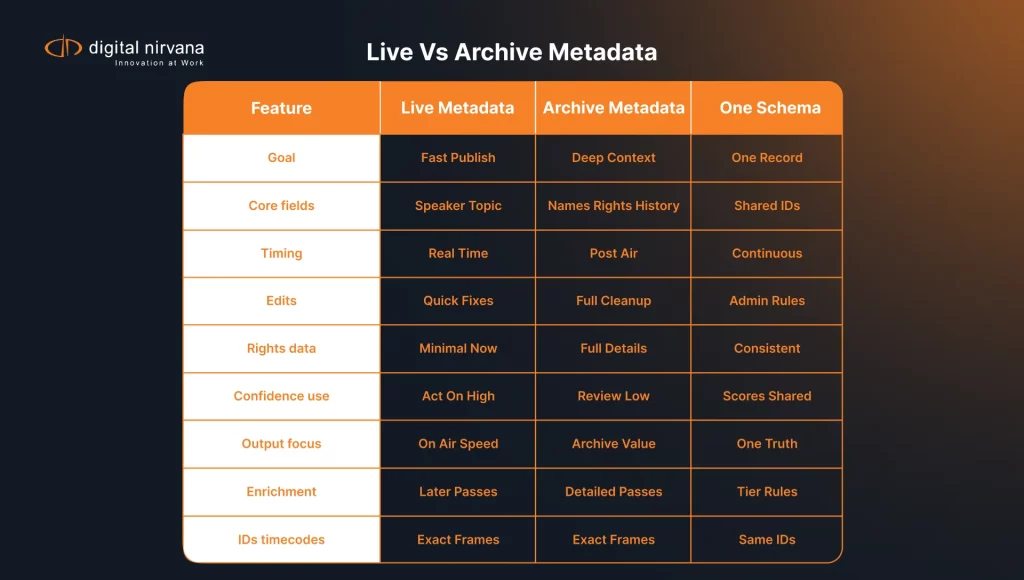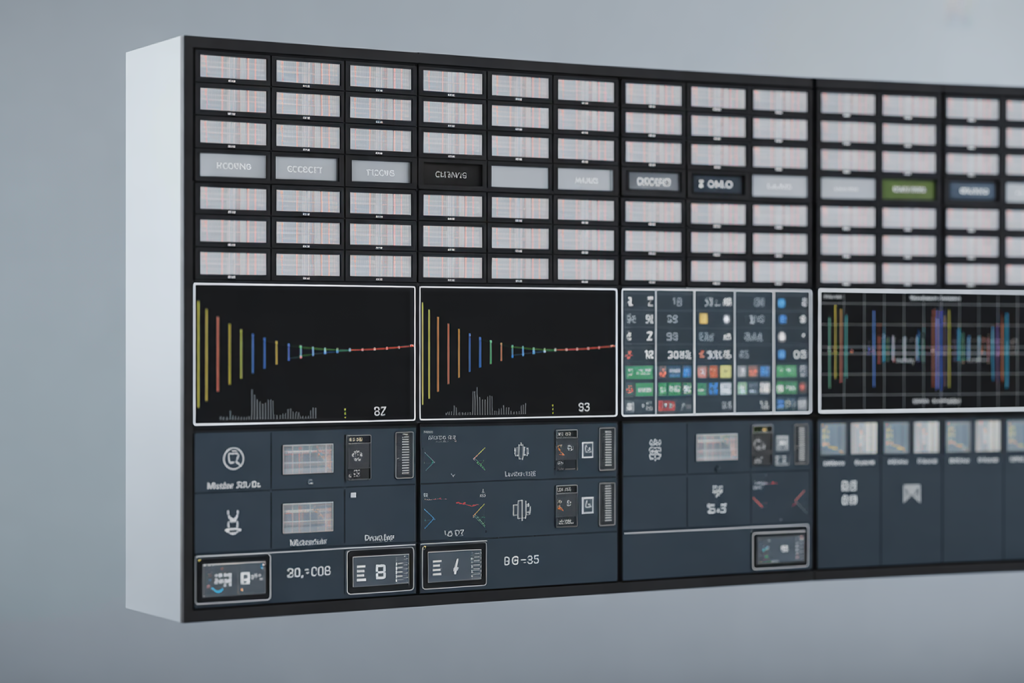News broadcast metadata and live broadcast metadata fuel faster rundowns, cleaner handoffs, and stronger revenue. Video metadata tied to timecode turns every spoken word and on-screen moment into searchable facts. Producers search in plain English, confirm speakers, and pull quotes without scrubbing. Engineers validate SCTE 35 cues and let tag-driven triggers pull the right lower third at the right second. Stations that standardize on MetadataIQ raise output, cut rework, and grow ad yield while staff focus on the show.
What News Broadcast Metadata Means for Today’s Producers
Producers race clocks, and metadata gives them a map they can trust. You capture people, places, topics, quotes, and screen elements, then anchor them to timecodes so the next move feels obvious. Metadata management lives inside the content workflow, not as homework after air. The newsroom speaks one language across NRCS, MAM systems, and playout so edits and triggers read the same truth. You move stories fast because the system shows who said what, where it happened, and how it aired.

Daily Wins You Can Feel
Editors jump to strong bites because classification metadata flags moments with confidence. Assignment desks filter newscast feeds by domain and beat, which keeps top-of-hour updates fresh. Control rooms trust markers that verify a graphic matched the script. Digital teams post clips fast because TV metadata and photo metadata ride with cuts into the CMS. Sales validates placements with logs that sponsors accept.
Core Fields That Make Content Easy to Find
Strong search starts with fields that match how producers think. You label speakers, titles, organizations, locations, and genres, then add visual elements like logos and lower thirds. You include rights, clearances, usage windows, and series slugs so distribution stays clean. Technical fields cover file format, data format, codec, captions state, and frame rate. Editorial fields capture quote text, summaries, and related scripts so results show meaning, not just IDs.
Field Design for Fast Action
Keep labels human and precise. Use person name, role, and affiliation rather than a vague entity tag. Record location with city, state, and country, plus GPS for field hits. Map CMS fields to the same schema so your website does not need duplicate entry. Tie every field to timecode and asset IDs so a click jumps to the exact frame. Let staff propose new tags that admins approve so the taxonomy grows with the beat.
Our Services at Digital Nirvana: Fast Wins Without Rebuilds
Our services at Digital Nirvana help U.S. newsrooms prove value in weeks, not months. MetadataIQ auto-tags people, topics, and logos with timecode. MonitorIQ handles compliance logging and SCTE 35 checks. TranceIQ delivers captions and translations that meet accessibility rules. When you need service help, our closed captioning services cover live and VOD. Engineering keeps control while producers gain speed.
Live Broadcast Metadata vs Archived Metadata
Live shows need speed and light fields while archives need depth and context. You tag speaker, topic, and confidence in real time, then enrich later with full names, alternate spellings, translations, and rights. Archive video gains value when you add preservation notes, member metadata, and marketplace usage history. The live record becomes the archive record, which preserves truth over time. One spine prevents duplication and keeps staff moving.

Manage Both Without Double Work
Run one schema with live and archive tiers. Workflow rules add fields as content moves from ingest to archive. AI fills first-pass labels while humans correct with quick clicks. Search stays consistent because both tiers share IDs and timecodes. Archivists handle preservations while producers keep shows on time.
Why Speed Beats Depth in Breaking News
Breaking news rewards teams that publish verified facts first. You tag the who, the what, and the where in seconds and mark risky claims for checks. You ship a lean but accurate record, then you layer in names, spellings, and summaries after the segment clears. Speed shapes the story while depth lands later for the archive. Viewers stay informed and trust grows because on-air facts hold up.
The Speed Playbook
Set time budgets for live tagging and stick to them. Capture essentials and use templates for weather, traffic, and sports so tags appear with one click. Flag low-confidence lines for the next block and move on. Measure minutes saved per block and per shift and share the wins. Keep crews focused on action, not forms.
Newsroom Automation Starts With Metadata, Not Macros
Automation drives value when metadata gives it context. Macros alone push buttons without thinking, while tag-driven logic loads the right lower third, bug, or squeeze back based on the story. Producers write cleaner scripts because the system understands intent. Engineers maintain fewer brittle templates because parameters live in data, not in hidden layers. You shift the control room from reaction to intent.
Let Metadata Drive Triggers, Not the Other Way Around
Tie triggers to tags like speaker, segment type, rundown position, and show. When a tag changes, the correct graphic loads and the right clip rolls without extra clicks. Directors still call timing, but they stop babysitting a pile of macros. Over time, you build a library of reliable, tag-driven automations that calm live control.
Rundown Changes That Update Everywhere at Once
Producers update the rundown, and graphics, prompter, and playout read the same change. MOS messages carry updates across tools, and the interface confirms status in real time. Editors and digital desks see new slugs and tags in their browser panels without email chains. Engineering stops cloning templates for every variant because parameters live in metadata. One change flows across the stack and the show keeps pace.
How Live Broadcast Metadata Drives Real-Time Production
Live tagging makes teams decisive. Producers see confidence scores update, directors cut with context, and editors start digital cuts while the segment airs. Sponsors trust placements because SCTE 35 cues hit clean. The newsroom turns content faster because the same labels power NRCS, MAM, and NLE at once. For deeper tactics, see this take on AI metadata tagging.
From Ingest to Rundown With Second by Second Tags
As feeds land, the system fingerprints audio and video and starts tagging names, topics, logos, and on-screen text. Those tags populate the rundown next to scripts and notes. Clips carry identity through the show, so context never falls off. Control rooms route sources with confidence because assets introduce themselves. After air, the same tags fuel search and reuse across the catalog.
On-Air Confidence With Verified Markers
Verified markers show that a lower third matched a speaker, a graphic matched the script, and a claim needed review. Producers act on high-confidence markers and queue checks on flagged items. Compliance later pulls the same markers to prove what aired and when. Sponsors value timestamped evidence during audits. Confidence shortens debates and speeds decisions.
Faster Highlights, Promos, and Social Clips
Editors hit the best quotes because tags flag strong soundbites and peaks. The system proposes rough cuts that producers tighten in minutes. Social teams export vertical cuts with burned-in captions and safe areas. Digital posts land while the story peaks, which lifts reach and revenue. The station stays in the feed instead of catching up. Our blog on metadata for monetization shows how tags turn into dollars.
Roadblocks in Most Newsrooms and How to Fix Them
The biggest drags are unsearchable archives, manual logging, and silos. Files hide in folders with no hint of context. Producers retype facts across tools to keep systems in sync. Editors skip legacy footage because no one mapped old labels to a modern schema. You fix these issues with one metadata layer that spans ingest, NRCS, MAM, and playout. For a practical blueprint, see our notes on metadata management services.
Unsearchable Archives
Batch enrichment tags people, places, topics, and logos across the back catalog. Map old fields to a modern metadata standard so search returns moments, not filenames. Add short summaries and quote markers to top shows. As the archive wakes up, long-tail stories gain depth without new shoots. The newsroom builds context on demand.
Manual Logging That Burns Producer Time
Manual logs steal minutes and break focus. Use AI for first-pass transcripts and tags, then let staff correct with quick clicks. Templates cut keystrokes and prevent spelling errors that break search. The system logs while you work, which trims overtime and burnout. Producers spend time shaping stories, not filling forms.
Metadata Silos Across MAM, NRCS, and Playout
Silos force duplication and slow updates. Bridge systems with MOS, APIs, watch folders, and database syncs so tags flow once and show up everywhere. Make the MAM the keeper of record for media identity while the NRCS owns editorial plan, then let playout read context it needs. One backbone keeps every seat in sync.
Why Top Broadcasters Choose MetadataIQ
Stations pick MetadataIQ for accurate real-time tagging, timecoded captions and translations, clean SCTE 35 validation, and open connectors that respect existing stacks. Producers see trustworthy topic, logo, and speaker tags. Engineers sign off because the platform supports MOS and documented APIs. Business teams like audit-ready logs that back revenue and compliance.
Real-Time AI Tagging for Names, Faces, Logos, and Topics
MetadataIQ recognizes speakers by voice and face, detects logos, and classifies topics as segments unfold. Tags arrive with timecodes, not vague ranges, so editors jump to usable moments fast. The model learns local names and recurring segments over time. Accuracy climbs while effort falls. Output rises without extra headcount.
Automatic Captions and Translations Tied to Timecode
Captions and translations share clocks with tags so every word lines up with picture. Producers publish multilingual digital cuts from the same record. Control rooms see caption health before air and fix issues early. Accessibility improves without new, separate tools. For policy context, the FCC closed captioning rules explain accuracy, timing, and completeness.
SCTE 35 Cue Validation for Clean Ad Breaks
The platform checks SCTE 35 markers and alerts staff when drift threatens a break. Engineers fix issues before they hit air. Sponsors receive logs that match affidavits by frame. Make-goods drop and fill rates rise. The ad plan lands clean and revenue grows.
APIs and MOS-Friendly Connectors for Smooth Handoffs
MetadataIQ moves context through MOS and documented APIs so every system keeps pace. NRCS items carry the same IDs as MAM assets, and playout reads what it needs. Engineering extends the stack with small scripts instead of big rebuilds. Vendors integrate fast because the contract speaks standards. Producers feel the lift in every seat.
What MetadataIQ Looks Like in a Live News Workflow
A live workflow runs on clear stages and clean handoffs. MetadataIQ starts at ingest, enriches through NRCS and MAM, and verifies outcomes after air. Producers see confidence scores that guide choices. Editors search in plain English across hours of footage and send selects to the NLE with tags intact. The workflow keeps moving because metadata travels with the media.
Ingest and Transcript With Speaker and Language ID
At ingest, the system starts a transcript and labels speakers and languages. It detects accents and recognizes regular guests. Producers fix name mismatches with one click. Engineers see language and caption status early and plan routes. The flow feels natural because it works while you stack the show.
Confidence Scoring Producers Can Trust
Confidence scores explain why the system suggests a tag or transcript line. Producers sort by high confidence to move fast and review low scores later. The model adapts to your taxonomy and beat as staff corrects edge cases. Trust grows because scores match on-air reality. The newsroom leans on facts, not hunches.
Search in Plain English Across Hours of Footage
Staff type questions the way they speak, and search returns moments, not just clips. The engine matches synonyms and beat terms, then filters by speaker, show, date, and location. Editors build shortlists in minutes and hand them to the control room or digital desk. The station saves hours per shift and publishes while stories peak. The browser panel keeps everyone in flow. For cleanup tips, this guide to data wrangling essentials helps keep fields tidy.
Send Selects to Editing With Timecoded Tags
Selects arrive in the NLE with tags attached to each subclip. Editors see names, topics, quotes, and rights on the timeline. Graphics pull the same context so supers hit on time. Producers avoid relabeling because context travels with the media. Delivery to playout or digital lands clean and fast.
Integrations That Matter to U.S. Broadcast Teams
Stations rely on an NRCS for planning, a MAM or PAM for assets, an NLE for craft, and playout for air. MetadataIQ fits that stack with MOS messages, API hooks, and panels that sit inside edit tools. The interface respects roles and access rules. Engineering keeps control, and producers get speed.
NRCS and Rundown Support With MOS Messages
MOS keeps scripts, graphics, and playout aligned. MetadataIQ uses MOS to move context as scripts change, so the right lower third follows the slug. Control rooms see status before a block starts. Engineers validate each MOS object so no element misses its cue. The show stays aligned under pressure.
MAM and PAM Enrichment Without Duplicate Entry
The platform enriches assets in the MAM without asking staff to retype facts. It pushes tags and captions into records and pulls rights and usage back for search. Editors open a clip and see everything in one pane. Archivists keep catalogs clean because the model maps to your taxonomy. Repetition drops and quality rises.
NLE Panel for Script-to-Screen Speed
Editors work faster when the panel shows tags next to the timeline. Staff search the catalog, drag selects, and keep tags intact as they cut. Producers drop script notes that appear in the panel, which keeps edits aligned to the rundown. Graphics teams pull the same context so supers hit on time. Script to screen moves without friction.
Roundtrip Notes and Approvals Captured as Metadata
Reviews leave a trail when feedback becomes metadata. Producers add notes, editors address them, and the system records the result with timestamps. Legal approvals travel with assets and show up before air. Control rooms avoid surprises because status sits in view. The trail protects the station and speeds reuse.
Metadata Standards That Keep Teams in Sync
Standards keep data portable across systems and partners. MetadataIQ maps to EBU Core and PBCore so records travel cleanly between vendors and preservation organizations. Stations keep a house taxonomy that fits beats and programs and still map to open models without loss. Interoperability rises when names, roles, and identifiers match across tools. Your catalog stays future-proof as tech shifts. For reference, explore PBCore and EBU’s EBU Core.
Practical Standards in Daily Work
Producers see EBU Core fields like title, subject, coverage, and contributor appear in forms they already use. Archivists export PBCore for long-term archiving and preservations so memory institutions can parse essence data and documentation. MAM systems store classification metadata and genres that match your programming grid. Clear mappings keep content portable and searchable across decades. Staff gain standards without extra burden.
Interoperability, Data Formats, and JSON in the Real World
Formats and interfaces decide how fast systems talk. MetadataIQ reads and writes JSON so APIs remain simple and predictable. The platform supports common data formats and file formats that broadcasters rely on for ingest and delivery. Database tables store normalized fields for speed while the search index keeps free text responsive. Teams pass records across a broadcast service or marketplace without rework.
What This Means for Engineering
Engineers wire endpoints once and focus on value, not glue code. Database design follows your domain model, which keeps queries fast and reports clear. Watch folders handle edge cases while APIs carry the main flow. Documentation explains fields that matter to producers, not just developers. Interoperability becomes a practice, not a promise.
Monetization and Compliance Powered by Metadata
Metadata protects ad slots, brand safety, and contracts. Clean cues raise ad yield, while rights and clearances data prevent painful takedowns. Audit logs show who approved what and when. The station earns trust by proving performance with timecodes that match affidavits. Money and risk both move in the right direction.
Better Ad Yield With Accurate SCTE 35 Markers
When cues align with content, ad servers hit on time and deliver planned exposure. The platform flags drift so engineers fix problems before air. Sponsors receive proof that matches frames, not guesses. Make-goods fall and fill rates rise. Revenue reflects operational discipline.
Brand Safety and Rights Checks in Seconds
Metadata flags sensitive topics, explicit language, and restricted footage before a block runs. Legal clears or blocks items with a click. Producers swap safer shots because search returns close matches. Rights and clearances travel with assets and keep distribution clean. The newsroom moves fast and stays within policy.
Audit-Ready Logs for Regulators and Partners
Logs prove what aired, who touched it, and which cues fired. Reports pull by show, segment, or campaign in minutes. Partners review evidence and move on. Reviews stop dragging because the data speaks plainly. Staff get back to news.
Quality, Security, and Control Producers Expect
Producers want accuracy and speed. Engineers want control and safety. MetadataIQ trains models with your taxonomy, protects personal data, and supports cloud, on prem, or hybrid setups. Business teams gain continuity because disaster recovery comes standard. Staff trust tools that stay responsive and secure.
Model Accuracy That Improves With Your Taxonomy
Your vocabulary lifts accuracy. The platform maps tags to beat-specific terms and trains on your footage. Over time, it recognizes local leaders, programs, and landmarks faster. Producers correct less and publish more. Accuracy climbs as effort drops.
PII Redaction and Policy-Based Access
The system detects and redacts PII in transcripts and tags. Admins set policies by role, show, and location, and panels enforce those rules. Audits show compliance without extra work. Staff move quickly within guardrails. Safety supports speed.
Cloud, On Prem, or Hybrid Based on Your Control
Every station balances latency, cost, and policy. MetadataIQ runs in the cloud, on your hardware, or as a hybrid that keeps media local while services scale. Engineering keeps keys and adjusts as needs change. The choice protects control while you modernize. Flexibility keeps you future-proof.
Disaster Recovery and Continuity Built In
Live news cannot pause. The platform replicates indexes and critical services and monitors health so failover lands fast. Engineering tests recovery during quiet blocks and fixes gaps. Logs reveal weak links you can patch early. Air time stays safe when a box fails.
Switching to MetadataIQ Without Disrupting On Air
A clean switch starts small, runs in parallel, and proves results. You pick one desk or show, connect the stack, and track time saved per story and per shift. Training covers beat vocabulary and quick actions staff use all day. You expand after you prove wins and confirm that no one loses speed. Leaders see numbers that back a full rollout.
Pilot With One Desk or Show First
Start with a morning block or a desk like politics or weather. Connect ingest, NRCS, MAM, NLE, and playout, then work a full cycle. Track search success, clip times, and ad cue accuracy for a real picture. Fix gaps before you add more shows. Pilots build confidence that spreads.
Run in Parallel to Prove the Wins
Keep the old workflow while MetadataIQ tags and routes in the background. Compare outcomes on the same content and share the numbers with crews. People back change when they see their own wins. Engineering trusts the plan because proof lives in air checks. Parallel runs build momentum.
Train the Beat-Specific Vocabulary
Load name lists, acronyms, and phrases that matter to each desk. Map synonyms and tune models with real segments. Producers correct less when the system speaks their language. Editors spend more time cutting than fixing labels. Training pays off in the first week.
Measure Time Saved per Story and per Shift
Pick metrics staff can feel. Track ingest-to-air time, search-to-find rate, clip turnaround, and ad cue accuracy. Share wins in stand-ups and reports so the team sees progress. Tie time saved to cost and output and forecast gains for the next show. Data turns support into investment.
Pricing, Licensing, and ROI You Can Defend
Leaders want elastic pricing and proof that returns outweigh costs. MetadataIQ offers seat and usage options, and unit cost falls as automation grows. CFOs accept ROI when you tie time saved to more output, fewer make-goods, and less overtime. Staff feel value in smoother shifts that deliver more clips and cleaner air. The model defends itself in numbers.
Seat and Usage Models That Scale With News Cycles
Core seats cover daily users, while usage handles spikes like elections, storms, and special reports. You avoid idle spend in slow weeks and cover surges without scrambling. Finance sees a straight line between output and cost. The plan matches how news runs.
Cost per Minute Falls as Automation Grows
As tag-driven automation expands, editors build more clips per hour and control rooms hit cleaner breaks. You publish more without hiring. Cost per minute drops and keeps dropping as models learn your beat. Scale puts math on your side. The trend stays durable.
ROI Math Your CFO Will Accept
Add overtime saved, make-goods avoided, higher yield from clean cues, and extra digital revenue from faster posts. Subtract license and integration costs. Show payback within quarters using logged evidence. Finance signs off when the ledger matches the story. Proof beats pitch.
Typical Payback Window for Mid-Market Stations
Many mid-market stations recover costs within the first few quarters. The biggest wins come from faster digital clips and cleaner breaks. Archives add value as enrichment spreads. Staff satisfaction rises as work shifts from retyping to producing. The return compounds as the catalog grows.
How U.S. Stations Buy and Deploy MetadataIQ
Buying and deploying a newsroom platform takes security sign-off, integration checks, and change management. Security teams review data flows, roles, and logs. Engineering teams run a checklist across ingest, NRCS, MAM, NLE, and playout. Managers invest in training and champions who support peers. A staged rollout locks in wins at each step.
Security Reviews and Data Residency
Security maps where media and metadata live and who can see them. The team checks encryption in transit and at rest and tests single sign-on and audit trails. Stations choose cloud, on prem, or hybrid based on policy. Vendors document residency when beats demand it. Clear reviews build trust before go live.
Integration Checklist for Engineering Leaders
Engineers list systems, versions, and endpoints and test small first. They validate MOS messages, API fields, watch folder behavior, and database table mappings. They confirm IDs match across NRCS and MAM and that playout reads context on time. They baseline latency and throughput and tune buffers. A checklist keeps the project tight.
Change Management for Producers and Editors
People adopt fast when the plan respects their day. Leaders schedule short sessions with real footage, not generic demos. Desk leads teach quick wins like search and one-click selects. Staff share tips in stand-ups, and managers collect feedback in one channel. Culture shifts because daily work gets easier.
Use Cases Across News, Sports, and Weather
MetadataIQ supports news, sports, and weather with one engine and beat-specific tuning. Newsrooms tag speakers and topics, sports teams mark plays and player appearances, and weather desks log alerts and map overlays. Producers pull context with the same search patterns across all three. Editing and playout see the same tags, which keeps handoffs smooth. One platform handles varied formats without extra headache.
Breaking News With Multilingual Sources
International stories bring multiple languages and fast updates. Translations arrive with timecodes, and producers scan highlights in English without losing nuance. The team publishes fast for a U.S. audience and posts multilingual versions for partners. Accuracy holds because captions, tags, and essence data share one clock. Reach grows without a staffing spike.
Election Night With Precinct and Candidate Tags
Election coverage needs precision at speed. MetadataIQ ties quotes and graphics to candidates, races, counties, and precincts. Producers update totals in the NRCS and see lower thirds and maps adjust on air. Digital teams post county pages with clips that match local interest. Viewers get clear results and context all night.
Sports Highlights With Rules-Based Markers
Sports desks tag plays by type, player, and outcome and stack highlight reels by quarter or period. Editors cut sponsor-ready packages in minutes. Social teams post standout moments before fans move on. The station delivers more sports with the same crew. Output climbs with the same payroll.
Weather Alerts and Map Overlays at Speed
Weather teams tag alerts by region, severity, and time window and tie them to map overlays. As a storm shifts, tags update and graphics follow. Producers push cut-ins with the right counties and instructions. Viewers see what matters to them in time to act. Trust grows with each alert that lands.
Why Digital Nirvana for U.S. Newsrooms
Digital Nirvana serves broadcasters with products built for compliance, monitoring, and metadata. MetadataIQ brings that heritage to live news with accurate AI tagging, MOS and API hooks, and caption and translation workflows. U.S. teams value support in their time zones and customer success playbooks tuned for fast-paced newsrooms. The company partners with engineering and editorial leads, not just procurement. Stations get a team that understands deadlines and proves outcomes.
Industry-Grade Compliance Heritage
Digital Nirvana built expertise in compliance logging, monitoring, and audit workflows. That DNA shows up in clean logs, robust caption chains, and frame-accurate markers. Engineering trusts an architecture that solves known pain points. Producers benefit when compliance tools and creative tools share APIs and schemas. The blend keeps shows fast and safe.
Support Aligned to Americas Time Zones
Live news needs quick answers during U.S. hours. Digital Nirvana supports stations when control rooms roll and editors cut shows. Customer teams join stand-ups during rollouts and respond with playbooks, not tickets. That rhythm matches newsroom life and sustains momentum. Staff feel backed without slowing down.
Customer Success Playbooks for News Teams
Success teams bring checklists for pilots, training, and go-live. They help set metrics, tune taxonomies, and schedule refreshers for new hires. Leaders see progress in dashboards, and staff see quick wins that stick. The approach turns a software purchase into durable change. Newsrooms grow capability while they keep air clean.
At Digital Nirvana, We Help You Launch and Scale
At Digital Nirvana, we help you run a short pilot, prove time saved, and expand with confidence. Product specialists connect MetadataIQ to your NRCS and MAM, and compliance teams validate breaks with MonitorIQ. Accessibility leads ship captions and translations through TranceIQ, and engineering manages ingest and delivery with MediaServicesIQ. Your staff keeps control while our team handles implementation, training, and support.
In summary…
A strong metadata layer speeds news, earns revenue, and keeps teams aligned. MetadataIQ fits U.S. stacks with MOS, JSON APIs, and standards like EBU Core and PBCore. It tags live content in real time, ships captions and translations, validates SCTE 35 cues, and enriches archives for preservations. A staged rollout proves wins while staff keep shows on air. The payoff shows up in minutes saved, clips shipped, and cleaner breaks.
- Operational gains
- Faster ingest to air across live shows.
- Search that returns moments rather than filenames.
- Tag-driven triggers that cut human error.
- Less duplicate entry across NRCS, MAM, and CMS.
- Faster ingest to air across live shows.
- Monetization and compliance
- Cleaner SCTE 35 markers and higher ad yield.
- Rights and clearances checks in seconds.
- Audit-ready logs for regulators and partners.
- Cleaner SCTE 35 markers and higher ad yield.
- Standards and interoperability
- EBU Core and PBCore mappings that preserve meaning.
- JSON APIs and documented data formats for partners.
- Interoperability across broadcast service and marketplace workflows.
- EBU Core and PBCore mappings that preserve meaning.
- Rollout and ROI
- Pilot first, run in parallel, then expand.
- Seat and usage models that scale with events.
- Payback in quarters as automation grows.
- Pilot first, run in parallel, then expand.
When you want calmer control rooms, faster clips, and stronger ad performance, move your newsroom to a metadata-first workflow. Review our primer on closed captioning guidelines and explore digital broadcast monitoring to see how these pieces connect.
FAQs
What is news broadcast metadata?
News broadcast metadata describes who speaks, what they say, where it happens, and how it appears on screen, all tied to exact timecodes. It spans video metadata, TV metadata, and photo metadata so cuts travel into web and app channels cleanly. Fields include rights, clearances, language, and technical details like file format and data format. Producers search this layer to find the right moments fast. Engineers use it to drive triggers and confirm ad cues.
How does live broadcast metadata work during breaking news?
During breaking news, the system tags speakers, topics, logos, and on-screen text in real time and assigns confidence scores. Producers act on high-confidence tags and queue checks on flagged claims. Editors start digital cuts while the segment airs because they can search the live record in the browser interface. Directors rely on tag-driven triggers for graphics and supers. After the block, teams enrich records for archiving without rework.
How does MetadataIQ integrate with existing systems?
MetadataIQ connects through MOS and JSON APIs so it fits NRCS, MAM systems, PAM, NLE, and playout stacks. It carries consistent IDs across tools and passes timecoded tags, captions, and SCTE 35 markers. Panels inside edit tools let staff search and drag selects with tags intact. Watch folders and webhooks support light handoffs when APIs are not available. The stack keeps interoperability without heavy rebuilds.
Can MetadataIQ support standards like EBU Core or PBCore?
Yes. The platform maps house fields to EBU Core and PBCore so archives, partners, and preservation organizations can parse records. Archivists export packages for preservations, and engineers keep daily work simple with house forms. The mapping preserves meaning across vendors and time. Standards protect your catalog from lock-in.
How accurate are the AI tags and transcripts?
Accuracy improves as the system learns your taxonomy and beat-specific names. Confidence scores guide producers to what they can trust first. Staff corrections feed the model so it gets better on local leaders, programs, and landmarks. Stations see strong precision out of the box and higher scores after short tuning. You gain speed without giving up editorial control.




